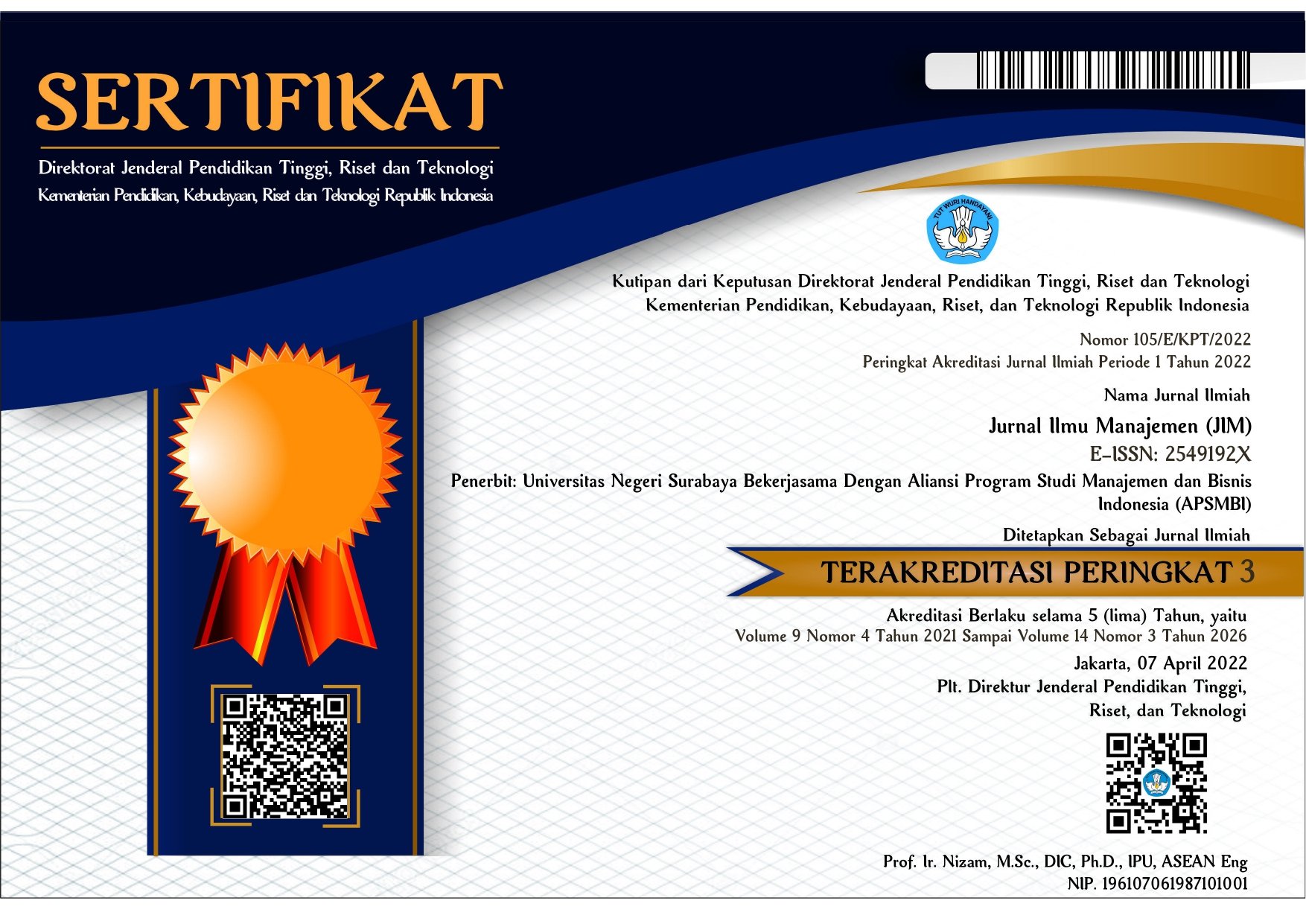Pengaruh career success terhadap career crafting dengan learning value of the job sebagai variabel moderasi
DOI:
https://doi.org/10.26740/jim.vn.p639-653Keywords:
Career Crafting, Learning Value Of The Job, Objective Career Success, Subjective Career SuccessAbstract
This study aims to test and analyze the effect of career success on career crafting with the learning value of the job as a moderating variable. The approach used in this study was quantitative. A survey was conducted among a sample of 77 employees. The data in this study were analyzed using the structural equation model partial least squares (SEM-PLS) with WarpPLS 8.0 software. The results show that objective career success has no effect on career crafting, subjective career success has a significant positive impact on career crafting, the moderating role of the learning value of the job weakens objective career success on career crafting, and the part of the learning value of the job does not moderate subjective career success towards career crafting. The implications based on the research results show that it is essential for companies to pay more attention and act to the sustainability of the perceived career success, both objective and subjective, and also learn the value of their employee's jobs to foster their proactivity career behaviours.
References
Ge, X., Gao, L., & Yu, H. (2023). A New Construct in Career Research: Career Crafting. Behavioral Sciences, 13(1), 49. https://doi.org/10.3390/bs13010049
Ghozali, Imam. 2016. Aplikasi Analisis Multivariete Dengan Program IBM SPSS 23 (Edisi 8). Cetakan ke VIII. Semarang: Badan Penerbit Universitas Diponegoro.
Ghozali, Imam & Latan, Hengky (2017). Partial Least Square: Konsep, Metode, dan Aplikasi menggunakan program WarpPLS 5.0, Edisi ke-3. Semarang: Badan Penerbit Universitas Diponogoro
Ghozali, Imam. (2021). Partial Least Squares: Konsep, Teknik, Dan Aplikasi Menggunakan Program Smartpls 3.2.9 Untuk Penelitian Empiris, Edisi 3. Semarang: Badan Penerbit Universitas Diponegoro.
Hirschi, A., & Koen, J. (2021). Contemporary career orientations and career self-management: A review and integration. Journal of Vocational Behavior, 126, Article 103505. https://doi.org/10.1016/j.jvb.2020.103505
Janssen, E., van der Heijden, B. I. J. M., Akkermans, J., & Audenaert, M. (2021). Unraveling the complex relationship between career success and career crafting: Exploring nonlinearity and the moderating role of learning value of the job. Journal of Vocational Behavior, 130, Article 103620. https://doi.org/10.1016/j.jvb.2021.103620
Thomas, W. H. N., Lillian, T. E., Kelly, L. S., & Daniel, C. F. (2005). Predictors of Objective and Subjective Career Success: a Meta-Analysis. Personnel Psychology, 58(2), 367-408. https://doi.org/10.1111/j.1744-6570.2005.00515.x.
Tims, M., & Akkermans, J. (2020). Job and Career Crafting to Fulfill Individual Career Pathways. In Career Pathways: From School to Retirement. Oxford University Press (Issue February), 165-190. https://doi.org/10.1093/oso/9780190907785.003.0010
Tri Wijayati, D., Fazlurrahman, H., Kholidi Hadi, H., Rahman, Z., & Kautsar, A. (2020). Coaching As Determinant of Job Performance: Co-working Support As Mediating Variable. KnE Social Sciences, April, 240-250. https://doi.org/10.18502/kss.v4i7.6855
Vidwans, M. (2016). Exploring career success with the new paradigm of career crafting. https://researcharchive.lincoln.ac.nz/handle/10182/8040
Downloads
Published
How to Cite
Issue
Section
License

This work is licensed under a Creative Commons Attribution-NonCommercial 4.0 International License.
 Abstract views: 747
,
Abstract views: 747
, PDF Downloads: 423
PDF Downloads: 423










